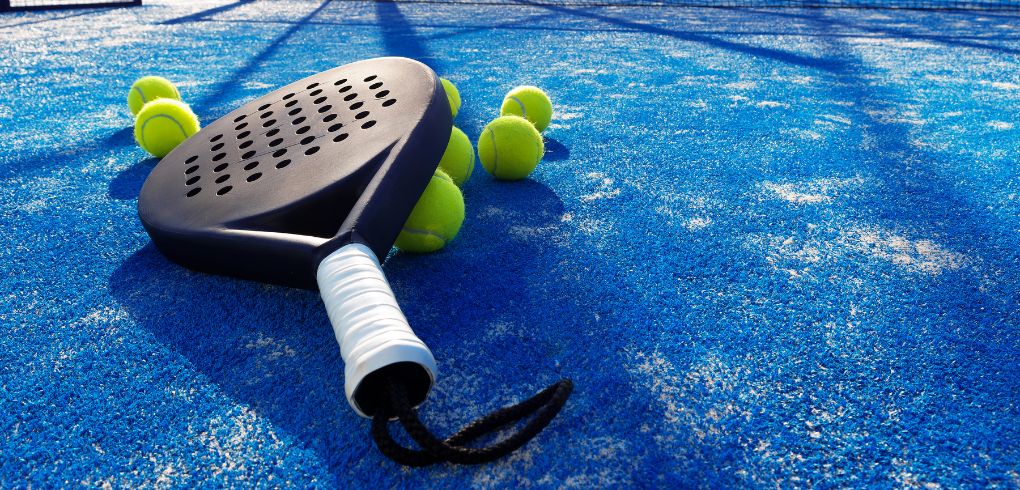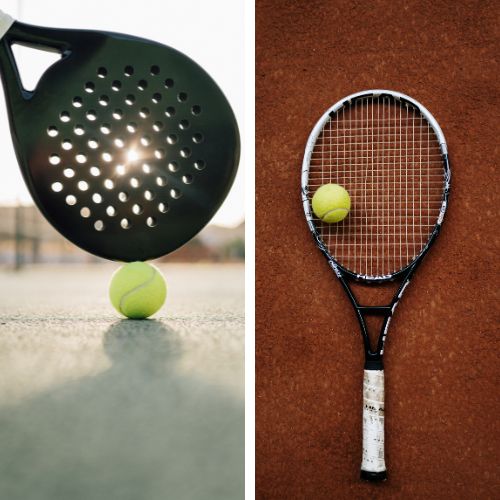
If you’ve noticed the growing buzz around padel recently, you’re not alone. This fast-paced, social, and engaging sport is quickly becoming popular with tennis enthusiasts looking to try something new and complete beginners seeking a fresh way to stay active. While tennis has long been a staple in British sports culture, padel’s recent surge in popularity is giving it some friendly competition.
In this blog, we’ll dive into the key differences and similarities between padel and tennis, from the rules, courts, and equipment to the skills required and social aspects of each sport. Whether you’re a seasoned tennis player or a newcomer weighing up which sport might suit you best, our in-depth comparison will guide you through the ins and outs of these two exciting racket sports.
What is padel?
Padel is a racket sport that combines elements of tennis and squash, typically played in doubles on a smaller, enclosed court about a third of the size of a tennis court. Originating in Mexico in 1969 and popularised in Spain, padel has rapidly increased in popularity. The game is fast-paced and highly social, with a key feature being the use of walls around the court, which allows players to bounce the ball off surfaces similar to squash. This mix of simplicity, fun, and intense rallies has made padel especially appealing for players of all ages and abilities, from casual participants to competitive athletes.
Basics of the game
Padel is generally considered easier than tennis. The smaller court size and the walls provide unique advantages that many players find beneficial. Unlike tennis, where rallies can become lengthy, padel encourages quick exchanges due to its dimensions. The sport is played on a rectangular area surrounded by walls. Players utilise these surfaces, which adds a layer of strategy.
Scoring in padel mirrors that of tennis, utilising the familiar 15, 30, 40 system. However, padel is predominantly a doubles game, fostering teamwork and collaboration. The game’s design allows for quick learning and immediate enjoyment, as newcomers can rapidly grasp the fundamental mechanics.

Padel vs tennis

Court and equipment differences
Padel and tennis differ significantly in court design and equipment. Padel occurs on a compact, enclosed area featuring glass walls, which permit distinctive rebound shots. Tennis is played on a larger, open field marked for singles and doubles matches.
Racket construction contrasts sharply as well. Padel utilises solid paddles with perforations and lacks strings, while tennis employs strung rackets, which vary in dimensions and tension. Ball characteristics also diverge. Despite being similar in size, padel balls maintain lower internal pressure, resulting in a unique bounce compared to their tennis counterparts.
Rules and scoring systems
Padel and tennis differ slightly in their rules and scoring systems. Both sports use the same point-based system, but padel allows players to use walls, adding a unique twist to the gameplay. An underhand serve is permitted in padel, enhancing its dynamic nature. In contrast, tennis mandates an overhand serve and prohibits wall interactions altogether. Due to the compact court size and rapid exchanges, padel matches typically conclude more swiftly. Tennis often requires greater physical effort, resulting in lengthier matches.
Gameplay dynamics and techniques
Padel and tennis gameplay mechanics and techniques present stark contrasts. Padel emphasises control, precision, and teamwork, resulting in an increased frequency of volleys. Players must develop quick reflexes and master wall usage. Tennis combines baseline and net strategies with specific approaches tailored for singles and doubles formats.
In padel, the focus lies on controlled strokes and strategic positioning. This fosters a collaborative environment, enhancing team dynamics. Tennis prioritises powerful serves and consistent topspin, often leading to more solitary play during singles matches.
Choosing between padel and tennis
Choosing between tennis and padel hinges on your individual preferences and aspirations. With a gentler learning curve, Padel caters well to novices and those seeking a more laid-back experience. This racket sport is easier on the joints, making it an appealing option for casual players. The unique strategy involving walls and the emphasis on doubles play significantly enhance the communal aspect of the game, fostering a lively atmosphere.
Tennis presents a more rigorous physical challenge that cultivates discipline and fitness. Engaging in tennis can elevate your overall athletic experience, providing physical benefits and a sense of connection to a larger sporting culture.
Ultimately, the decision should reflect your fitness ambitions and social interactions. Selecting the sport that resonates with your lifestyle ensures enjoyment on the court while reaping each sport’s diverse advantages.
Play padel at Bluecoat Sports
Both tennis and padel offer excellent ways to stay active and engaged in racket sports. Ready to try padel for yourself? We’re proud to be introducing four new state-of-the-art padel courts, coming soon in 2025! We also offer a wide range of other racket sports, including tennis, squash, pickleball and badminton. Book a racket sports court online today.

FAQs
Are padel balls different to tennis balls?
Yes. A padel ball has less pressure and is slightly smaller than a tennis ball. They’re designed to bounce less, which suits the smaller padel court and enclosed playing area.
Is padel easier than tennis?
For most beginners, padel has a gentler learning curve than tennis. The court is smaller, the padel racket is more compact and easier to control, and the enclosed space means rallies tend to last longer. However, mastering advanced padel techniques requires just as much skill and dedication as tennis.
Can you play padel on a tennis court?
No. Padel requires a specific court with glass walls around it. The court measures 10m x 20m, while tennis courts are much larger at 23.77m x 10.97m. The walls are critical elements of padel gameplay, as players can use them strategically during rallies.
Is padel tennis?
No. While both are racket sports, padel has distinct rules, equipment, and court specifications. Padel uses solid rackets (not stringed), enclosed courts with walls, and different scoring systems. It’s typically played only in a doubles format.
Can you play padel with tennis balls?
You can physically hit tennis balls in padel, but it won’t create the right playing experience. Tennis balls bounce too high and move too fast for padel’s smaller court size and enclosed space. Proper padel balls are necessary for the correct game dynamics and enjoyment.